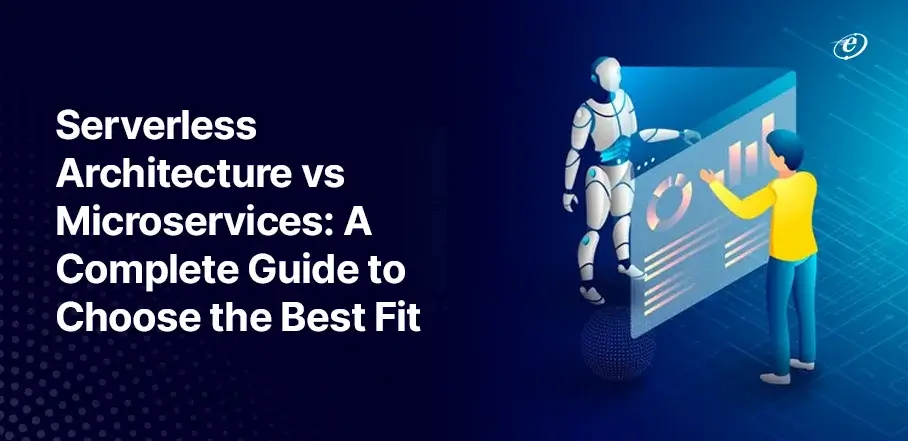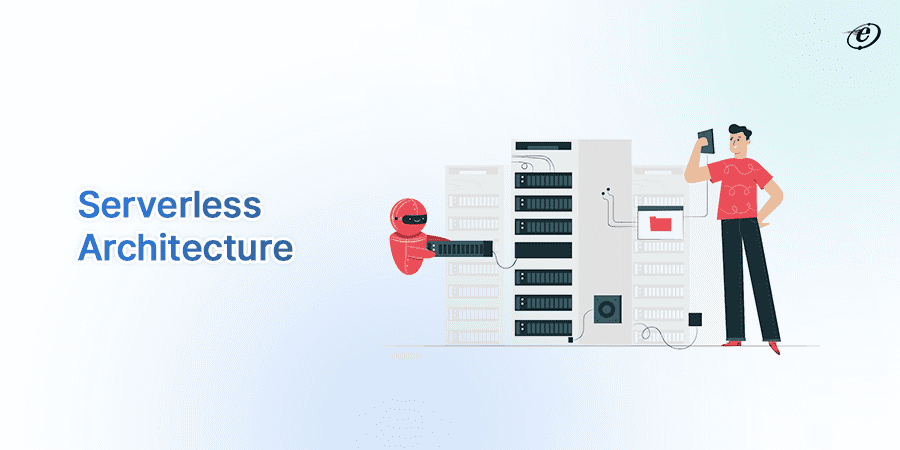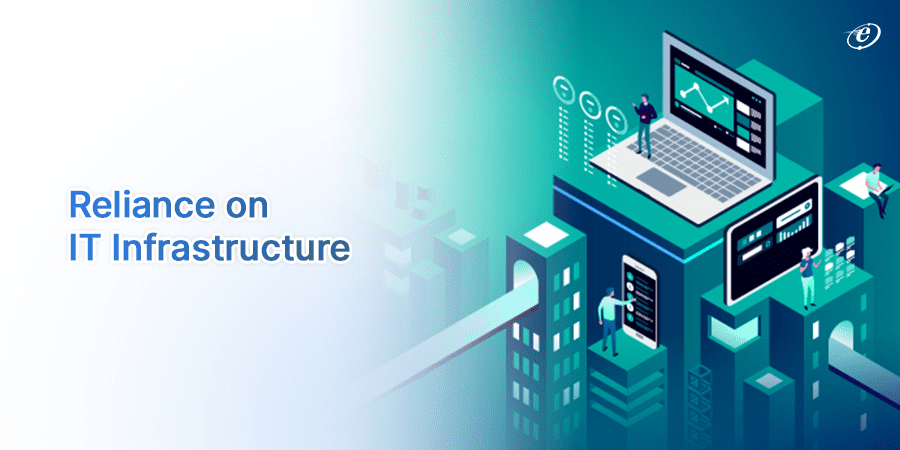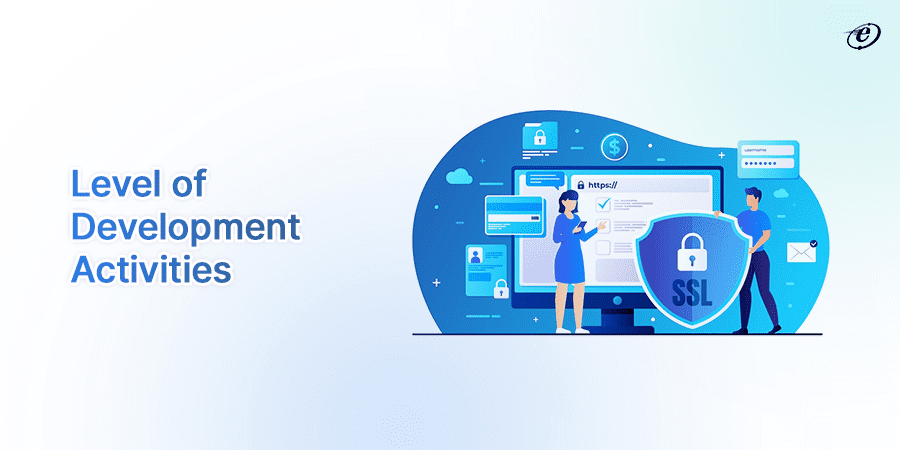
Serverless vs Microservices: Which Architecture is best Your Next Project?
In the IT sector, you often encounter a popular comparison topic – serverless vs microservices. Both choices promise agility, scalability, and efficiency, but they’re like peanut butter and jelly – delicious in very different ways.
Serverless lets you code without managing servers. On the contrary, microservices break down applications into bite-sized, independent pieces, like a modular wardrobe for your app.
And guess what? The serverless market is growing exponentially and can boom at a mind-blowing CAGR of 37.1% by 2025!
So, which one should you choose? Scroll ahead as we dive into the serverless architecture vs microservices showdown – let’s see which option suits your style!
Serverless vs Microservices: Understanding the Basics
Before decoding the microservices vs serverless comparison, it is essential to know both concepts.
What is Serverless Architecture?
So, what is serverless?
Imagine a restaurant where you only pay for the dishes you eat, and the kitchen magically appears and disappears as needed. That’s serverless!

Technically speaking, you write code snippets that run on-demand instead of renting a whole server. The cloud provider handles the rest, scaling up and down as per your requirement, so you only pay for what you use.
So, who can benefit from choosing a serverless architecture?
Startups, event-driven businesses like API providers, and agility-seeking companies can thrive on serverless’s pay-per-use model.
The Advantages of Serverless Architecture
Here are the main benefits of choosing serverless architecture for your software development project:
-
Reduced Cost: With this option, you only pay for the resources you use
-
Increased Developer Focus: Developers can focus on writing code for the core functionalities of the application
-
Improved Scalability: Serverless architectures can automatically scale up or down based on demand
-
Faster Deployments: Serverless deployments are much faster than their traditional counterparts
-
Increased Flexibility: These architectures are highly flexible and have good integration capabilities
Overall, serverless architecture can be a great option for developers who are looking to build cost-effective, scalable, and easy-to-manage applications.
What Are Microservices?
Now, let’s understand microservices in simple terms.
Picture building a giant robot with a team of friends, each building a different part (arms, legs, brain). Microservices are like that!

Each part (a service) is small, independent, and works on its own, like your friend building the leg. You can deploy and update the parts separately without affecting the others.
This makes the end product flexible and adaptable, like upgrading your phone without replacing your whole house.
Now, the main point is – who are the primary beneficiaries of this architecture?
Well, businesses with complex, evolving applications benefit most from microservices. This strategy is ideal for organizations like e-commerce giants and large software development teams.
The Advantages of Microservices Architecture
Here are the main benefits of using microservices architecture models:
-
Improved Scalability: Each microservice is independent, allowing you to scale up specific services based on demand without affecting others
-
Enhanced Fault Isolation: If one microservice fails, it typically won’t impact other services
-
Technology Agnosticism: You can develop microservices using different programming languages and technologies
-
Faster Development and Deployment: Smaller, independent services are easier to develop, test, and deploy
-
Improved Maintainability: With smaller codebases, it’s easier for developers to understand, modify, and maintain individual microservices
- Easier Experimentation: The modular nature of microservices allows for easier experimentation with new technologies
Overall, microservices architecture can lead to more agile, scalable, and maintainable applications. However, it’s important to consider the increased complexity that comes with managing multiple services.
Delving into the Serverless vs Microservices Comparison
Let’s get it straight. Not all of you want to explore every detail of this comparison. The microservices vs serverless differentiation has vast potential.
So, for those of you who want a glance, just go through the following serverless vs microservices table:
CostPay-per-use, scales automaticallyCan be expensive for long-running tasksCost-conscious businesses with variable workloads
| Feature | Serverless | Microservices | Suitability |
| Server Management | Cloud provider handles everything | You manage the servers and infrastructure | Businesses with limited IT resources |
| Development Effort | Focus solely on code, faster development | Requires more planning and architecture | Agile businesses with rapid release cycles |
| Cost | Pay-per-use, scales automatically | Can be expensive for long-running tasks | Cost-conscious businesses with variable workloads |
| Scalability | Scales instantly based on demand | Requires manual scaling of individual services | Businesses with unpredictable traffic spikes |
| Complexity | Simpler architecture, easier to learn | More complex, requires team coordination | Businesses with complex, evolving applications |
Here’s the bottom line to consider while drawing conclusions from the serverless vs microservices debate:
- Serverless is suitable for businesses that want to pay as they go, build fast, and scale effortlessly, like startups and API-powered companies
- Microservices work best for companies with complex, evolving apps where smaller, independent teams need to build and update features quickly
Now that you understand the main differences, let’s address each aspect in depth.
Are you looking for an offshore team that can handle serverless as well as microservices projects?
The Serverless vs Microservices Difference
This section is an extension of the main comparison table. So, after reading, you will get a deep understanding of each parameter in the serverless architecture vs microservices comparison.
1. Server Management

The serverless vs microservices comparison begins with technical management. Both architecture styles offer distinct approaches to handling the crucial aspect of server management.
In serverless architecture, you write your code as independent functions, and the cloud provider takes care of everything behind the scenes.
Here are the main points to consider:
- Provisioning: You don’t need to set up servers manually. The cloud scales resources automatically based on your code’s execution
- Patching and Maintenance: The provider ensures your functions run on the latest infrastructure
- Scaling: Functions scale instantly based on demand, eliminating the need for manual configuration
As a result, you can experience the following main advantages:
| Reduced operational costs | Simple infrastructure management |
| High cost effectiveness | Fast development cycles |
In the microservices architecture, you are responsible for managing the infrastructure.
Consider these points:
- Containerization: Each service runs in its own container, ensuring isolation and independent scaling
- Orchestration: Tools like Kubernetes help manage and coordinate the deployment and scaling of individual services
- Monitoring and Logging: You’re responsible for monitoring each service’s health and performance
Through this approach, you can have the following advantages:
| High flexibility | Increase in overall efficiency |
| Improvement in reliability | More control over SDLC |
So, who wins in this serverless vs microservices comparison?

2. Development Effort

The serverless vs microservices comparison is crucial to understand for planning your development strategy.In the serverless model, you focus solely on crafting independent functions, leaving server management to the cloud provider.
This streamlining leads to the following benefits:
- Reduced Development Complexity: Serverless minimizes infrastructure concerns, simplifying the development process
- Faster Time to Market: Streamlined development and automatic scaling allow for rapid prototyping and deployment
- Minimal Operational Overhead: You can focus on core functionality without worrying about server management tasks
Still, these are some points that can prove challenging while implementing the serverless architecture:
| Fewer customization possibilities | More reliance on cloud providers |
| Potential issues during debugging | Low level of flexibility |
On the contrary, the microservices architecture focuses on a divide-and-conquer approach.
This granularity offers the following benefits:
- Modular Development: You can work on individual services simultaneously, promoting faster development
- Independent Deployment: There is an increased potential for deploying services independently
- Technology Agnosticism: Microservices enable high functionality from specific technologies, allowing for diverse technology choices
However, microservices also pose the following challenges:
| Increase in overall complexity | Time-consuming testing |
| High operational costs | Requirement for efficient containerization |
So, which is more suitable for you in this serverless architecture vs microservices differentiation?

3. Cost

Our serverless vs microservices comparison moves towards the financial aspect. Understanding that both approaches offer you distinct benefits and challenges is vital.With the serverless architecture model, you only incur costs for the resources your functions utilize.
So, here are the main advantages:
- Best for event-driven applications: You can handle such projects with additional expenses
- Short-lived tasks: You only pay for the brief execution time of your functions
- Suitable for cost-conscious startups: Minimal upfront investment and flexible billing make this strategy budget-friendly
On the other hand, the serverless model has the following challenges or limitations:
| Slow execution of initial functions | More costs for external data transfer |
| Variable pricing models of cloud providers |
The microservices model provides fine-grained control over costs.
So, you can experience the following benefits:
- Optimization of resource allocation: You can scale individual services independently, minimizing unnecessary resource usage
- Leverage open-source options: It is possible to utilize free or low-cost technologies for specific services, reducing overall cost
- Avoid vendor lock-in: Businesses like yours can maintain flexibility by choosing customized on-premises infrastructure
Now, similar to the serverless model, this strategy has some evident challenges:
| High operational costs | Increased maintenance costs |
| Potential inefficiency in expenditures |
So, what is the final verdict in this microservices vs serverless comparison point?

4. Scalability

The ability to adapt to dynamic demands is crucial for any modern application. Regarding scalability, the serverless vs microservices comparison has distinct points for you to consider.
Serverless architecture is well-suited for automatic scaling. As your application’s demand fluctuates, the cloud provider seamlessly changes the resources to match your custom needs.
This approach offers the following advantages:
- Effortless Scaling: You can focus solely on code, leaving scaling complexities to the cloud provider
- Fine-grained Scalability: Functions scale automatically based on individual execution requests, maximizing resource efficiency
- Cost-effectiveness: You only pay for the resources your functions utilize, minimizing waste during low traffic periods
Along with the main benefits, the serverless model also has some limitations.
Take a look at the primary challenges:
| Less control over the scaling mechanism | Potential delay in initial scaling |
| Low flexibility |
Now, moving on to microservices. This architecture empowers granular scaling. You can scale each service independently based on its specific needs.
Here are the main advantages of using the microservices architecture:
- Agile Adaptability: It is possible to scale individual services to meet fluctuating demand, enhancing overall application responsiveness
- Technology Diversity: Different services can utilize diverse technologies and scaling approaches, optimizing resource utilization
- High Resilience: Failure in one service doesn’t impact others, ensuring application stability
However, microservices scalability also comes with its own set of challenges:
| Increase in management complexity | Possibility of over-provisioning |
| High overhead costs | Requirement of dedicated resources |
So, in this serverless vs microservices architecture point, which one should you prefer?

5. Complexity

The last point in the serverless vs microservices debate hovers around technical complexity. Serverless architecture is simple to implement. Developers focus on crafting functions, leaving server management and infrastructure complexities to the cloud provider.
So, you can notice the following main benefits:
- Reduced Development Effort: Developers can code without worrying about servers, accelerating development cycles
- Simplified Operations: You don’t need to worry about server management and scaling
- Faster Time to Market: Streamlined development and automatic scaling allow for rapid prototyping and deployment
Still, the following challenges can make you think twice before implementing the serverless architecture:
| Limitations on troubleshooting activities | Less flexibility due to vendor lock-in |
| Less control on performance optimization | Challenges while debugging and error handling |
Now, let’s consider microservices. Microservices architecture embraces a divide-and-conquer approach, breaking down applications into independent services.
So, you experience the following main advantages:
- Modular Development: Your team can work on individual services in parallel, promoting faster development
- Independent Deployments: It is possible to launch services independently
- Technology Agnosticism: Microservices decouple functionality from specific technologies, allowing for diverse technology options
With all these primary benefits, you can still face the following challenges with microservices:
| Managing multiple services can become cumbersome | Testing can become time-consuming |
| High operational costs |
So, what is the conclusion of this serverless vs microservices comparison point?

How to Choose Between Serverless and Microservices Models?
You want to know the exact points to choose between serverless and microservices architectures, right?
Well the choice depends on your specific project requirements and priorities. Here are the crucial facets that can help you decide the best option:
Consider serverless under the following circumstances:
- Cost is a major concern
- You need fast development and deployment
- Your application is stateless and scales rapidly
On the other hand, you can consider microservices under the following scenarios:
- You need fine-grained control and customization
- Your application is complex and requires long-term scalability
- You have an existing development team comfortable with managing multiple services
The best approach depends on your specific needs. So, you should evaluate your project requirements, resource constraints, and team expertise to make an informed decision.
Need guided assistance on choosing the best architecture and tech stack for your project? Talk to our expert today!
Combining Serverless and Microservices: The Best of Both
While serverless and microservices architectures each offer distinct advantages, as we read above, combining the two can create a powerful, efficient, and scalable solution for your organization. This hybrid approach leverages the strengths of both paradigms to address various development and operational needs.
Scroll down to learn more about it.
Granular Scaling and Resource Utilization
Integrating serverless functions into your microservices framework allows you to scale each microservice independently based on its specific workload. For instance, a serverless function handling user authentication during high-traffic periods can automatically scale without impacting your other services. This ensures optimal resource utilization, as resources are allocated only where and when needed.
Accelerated Development and Deployment
Serverless microservices allow your developers to focus on writing code for specific functions and services, reducing the complexity of your infrastructure management. This results in faster development cycles and quicker time to market for new features.
Reduced Operational Complexity
Adopting a serverless microservices approach will minimize your operational complexities. The serverless model eliminates the need for server provisioning and maintenance, while microservices allow for modular development. This reduces your risk of infrastructure-related errors and decreases operational overhead, allowing your teams to concentrate on core functionality and innovation.
Cost Efficiency and Flexibility
Serverless microservices operate on a pay-as-you-go billing model, which will save you extra cost. This ensures that you only pay for the computing resources that you actually use, avoiding the expenses related to idle resources. Additionally, microservices’ flexibility allows each service to be developed using the most suitable technology stack, enhancing the overall adaptability and efficiency of your application.
Improved Resilience
The isolation between microservices ensures that a failure in one service does not cascade to others, maintaining the overall stability of your application. Serverless functions further enhance resilience with their ability to automatically scale in response to demand, ensuring consistent performance during unexpected traffic spikes.
To Sum Up
The serverless vs microservices comparison boils down to your specific needs and priorities. Choosing the serverless model is appropriate for cost-effectiveness, scalability, and development speed.
On the other hand, the microservices architecture is suitable for large complex projects. With this approach, you can avoid vendor lock-in and monitor individual services for greater development control.
Overall, the best choice between serverless architecture vs microservices depends on your project’s requirements. If you still need help implementing the most suitable model, contact our team to make the right choice.
Frequently Asked Questions
1. Can a customized microservice be serverless?
Yes. You might be studying the serverless vs microservices comparison to choose the best model. But the combination, i.e., serverless with microservices, can prove effective. Such architecture is easy to build and deploy on cloud providers’ infrastructure, eliminating server management overhead.
2. Is Kubernetes a serverless type of architecture?
No, Kubernetes itself is not serverless. It is a deployment framework that manages containers. Serverless frameworks like Knative can run on Kubernetes, providing a serverless experience within its container-based environment.
3. What are Microservices architecture real-world examples?
Applications like Amazon, Netflix, Spotify, Uber, etc are the real-world examples of Microservices architecture.
4. What are Serverless architecture real-world examples?
Google cloud platforms, Netflix, Slack chatbots, AWS Lambda, etc are the real-world examples of Serverless architecture.





